Nan Ma
VQ-VAE Based Digital Semantic Communication with Importance-Aware OFDM Transmission
Aug 12, 2025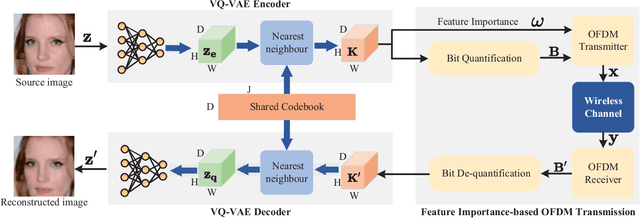
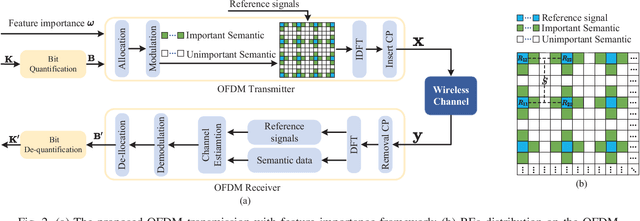
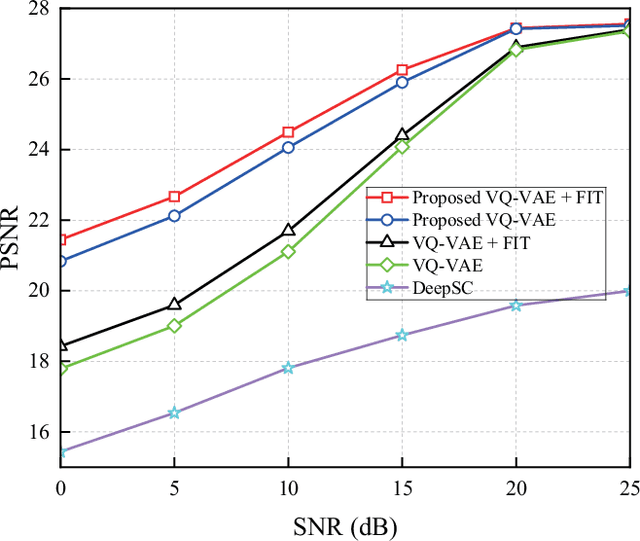
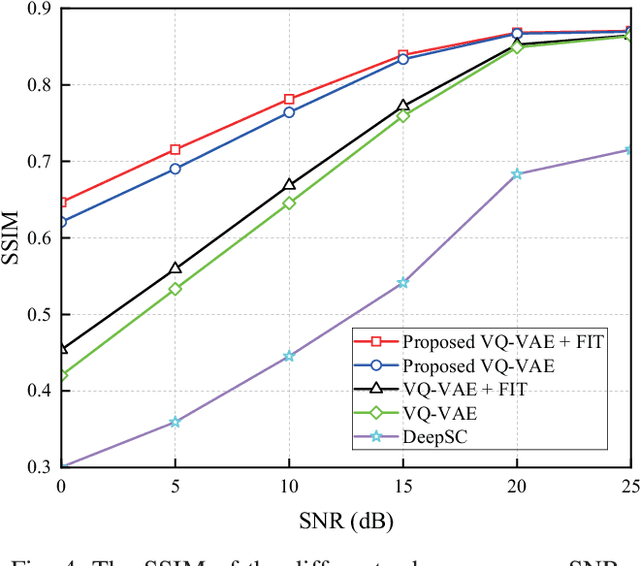
Abstract:Semantic communication (SemCom) significantly reduces redundant data and improves transmission efficiency by extracting the latent features of information. However, most of the conventional deep learning-based SemCom systems focus on analog transmission and lack in compatibility with practical digital communications. This paper proposes a vector quantized-variational autoencoder (VQ-VAE) based digital SemCom system that directly transmits the semantic features and incorporates the importance-aware orthogonal frequency division multiplexing (OFDM) transmission to enhance the SemCom performance, where the VQ-VAE generates a discrete codebook shared between the transmitter and receiver. At transmitter, the latent semantic features are firstly extracted by VQ-VAE, and then the shared codebook is adopted to match these features, which are subsequently transformed into a discrete version to adapt the digital transmission. To protect the semantic information, an importance-aware OFDM transmission strategy is proposed to allocate the key features near the OFDM reference signals, where the feature importance is derived from the gradient-based method. At the receiver, the features are rematched with the shared codebook to further correct errors. Finally, experimental results demonstrate that our proposed scheme outperforms the conventional DeepSC and achieves better reconstruction performance under low SNR region.
AHPPEBot: Autonomous Robot for Tomato Harvesting based on Phenotyping and Pose Estimation
May 11, 2024



Abstract:To address the limitations inherent to conventional automated harvesting robots specifically their suboptimal success rates and risk of crop damage, we design a novel bot named AHPPEBot which is capable of autonomous harvesting based on crop phenotyping and pose estimation. Specifically, In phenotyping, the detection, association, and maturity estimation of tomato trusses and individual fruits are accomplished through a multi-task YOLOv5 model coupled with a detection-based adaptive DBScan clustering algorithm. In pose estimation, we employ a deep learning model to predict seven semantic keypoints on the pedicel. These keypoints assist in the robot's path planning, minimize target contact, and facilitate the use of our specialized end effector for harvesting. In autonomous tomato harvesting experiments conducted in commercial greenhouses, our proposed robot achieved a harvesting success rate of 86.67%, with an average successful harvest time of 32.46 s, showcasing its continuous and robust harvesting capabilities. The result underscores the potential of harvesting robots to bridge the labor gap in agriculture.
Semantic Entropy Can Simultaneously Benefit Transmission Efficiency and Channel Security of Wireless Semantic Communications
Feb 07, 2024Abstract:Recently proliferated deep learning-based semantic communications (DLSC) focus on how transmitted symbols efficiently convey a desired meaning to the destination. However, the sensitivity of neural models and the openness of wireless channels cause the DLSC system to be extremely fragile to various malicious attacks. This inspires us to ask a question: "Can we further exploit the advantages of transmission efficiency in wireless semantic communications while also alleviating its security disadvantages?". Keeping this in mind, we propose SemEntropy, a novel method that answers the above question by exploring the semantics of data for both adaptive transmission and physical layer encryption. Specifically, we first introduce semantic entropy, which indicates the expectation of various semantic scores regarding the transmission goal of the DLSC. Equipped with such semantic entropy, we can dynamically assign informative semantics to Orthogonal Frequency Division Multiplexing (OFDM) subcarriers with better channel conditions in a fine-grained manner. We also use the entropy to guide semantic key generation to safeguard communications over open wireless channels. By doing so, both transmission efficiency and channel security can be simultaneously improved. Extensive experiments over various benchmarks show the effectiveness of the proposed SemEntropy. We discuss the reason why our proposed method benefits secure transmission of DLSC, and also give some interesting findings, e.g., SemEntropy can keep the semantic accuracy remain 95% with 60% less transmission.
Spectrum-guided Feature Enhancement Network for Event Person Re-Identification
Feb 02, 2024Abstract:As a cutting-edge biosensor, the event camera holds significant potential in the field of computer vision, particularly regarding privacy preservation. However, compared to traditional cameras, event streams often contain noise and possess extremely sparse semantics, posing a formidable challenge for event-based person re-identification (event Re-ID). To address this, we introduce a novel event person re-identification network: the Spectrum-guided Feature Enhancement Network (SFE-Net). This network consists of two innovative components: the Multi-grain Spectrum Attention Mechanism (MSAM) and the Consecutive Patch Dropout Module (CPDM). MSAM employs a fourier spectrum transform strategy to filter event noise, while also utilizing an event-guided multi-granularity attention strategy to enhance and capture discriminative person semantics. CPDM employs a consecutive patch dropout strategy to generate multiple incomplete feature maps, encouraging the deep Re-ID model to equally perceive each effective region of the person's body and capture robust person descriptors. Extensive experiments on Event Re-ID datasets demonstrate that our SFE-Net achieves the best performance in this task.
FF-LOGO: Cross-Modality Point Cloud Registration with Feature Filtering and Local to Global Optimization
Sep 16, 2023Abstract:Cross-modality point cloud registration is confronted with significant challenges due to inherent differences in modalities between different sensors. We propose a cross-modality point cloud registration framework FF-LOGO: a cross-modality point cloud registration method with feature filtering and local-global optimization. The cross-modality feature correlation filtering module extracts geometric transformation-invariant features from cross-modality point clouds and achieves point selection by feature matching. We also introduce a cross-modality optimization process, including a local adaptive key region aggregation module and a global modality consistency fusion optimization module. Experimental results demonstrate that our two-stage optimization significantly improves the registration accuracy of the feature association and selection module. Our method achieves a substantial increase in recall rate compared to the current state-of-the-art methods on the 3DCSR dataset, improving from 40.59% to 75.74%. Our code will be available at https://github.com/wangmohan17/FFLOGO.
A Wideband MIMO Channel Model for Aerial Intelligent Reflecting Surface-Assisted Wireless Communications
Sep 05, 2023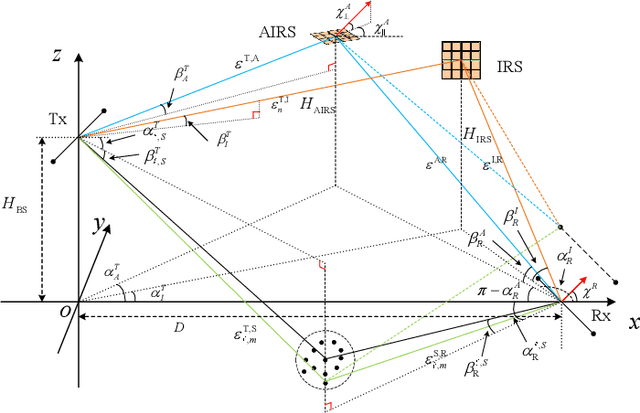
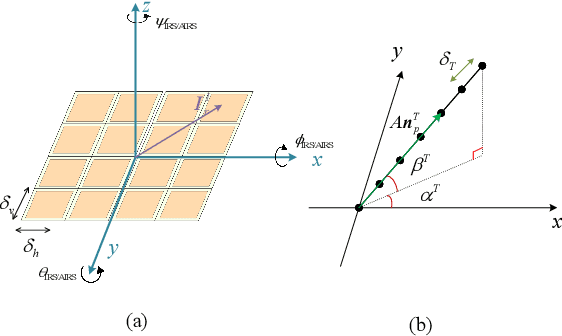
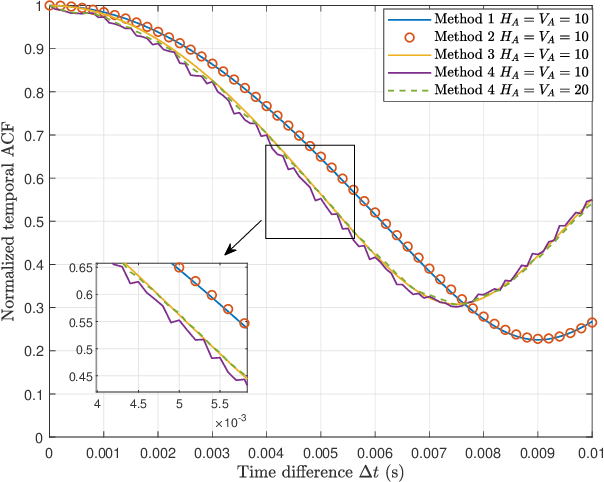
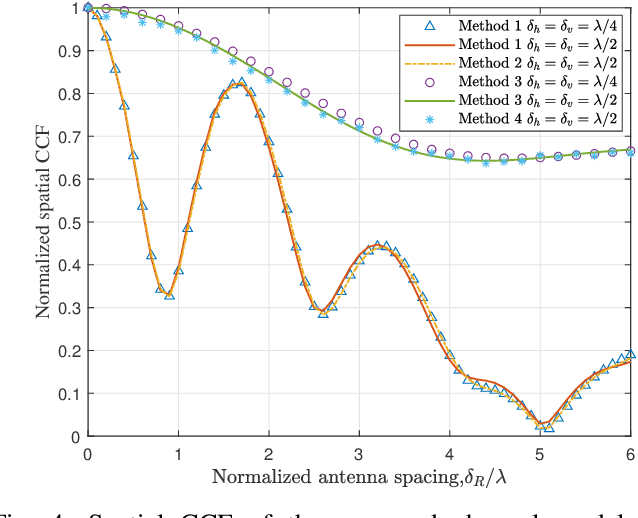
Abstract:Compared to traditional intelligent reflecting surfaces(IRS), aerial IRS (AIRS) has unique advantages, such as more flexible deployment and wider service coverage. However, modeling AIRS in the channel presents new challenges due to their mobility. In this paper, a three-dimensional (3D) wideband channel model for AIRS and IRS joint-assisted multiple-input multiple-output (MIMO) communication system is proposed, where considering the rotational degrees of freedom in three directions and the motion angles of AIRS in space. Based on the proposed model, the channel impulse response (CIR), correlation function, and channel capacity are derived, and several feasible joint phase shifts schemes for AIRS and IRS units are proposed. Simulation results show that the proposed model can capture the channel characteristics accurately, and the proposed phase shifts methods can effectively improve the channel statistical characteristics and increase the system capacity. Additionally, we observe that in certain scenarios, the paths involving the IRS and the line-of-sight (LoS) paths exhibit similar characteristics. These findings provide valuable insights for the future development of intelligent communication systems.
An Entire Renal Anatomy Extraction Network for Advanced CAD During Partial Nephrectomy
May 23, 2023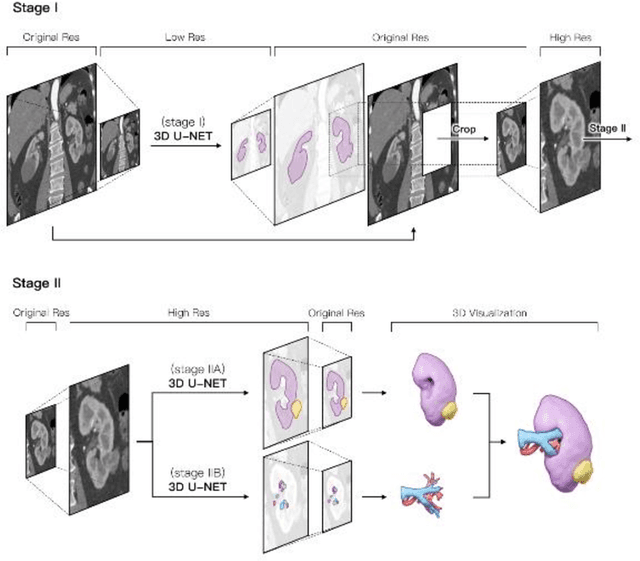
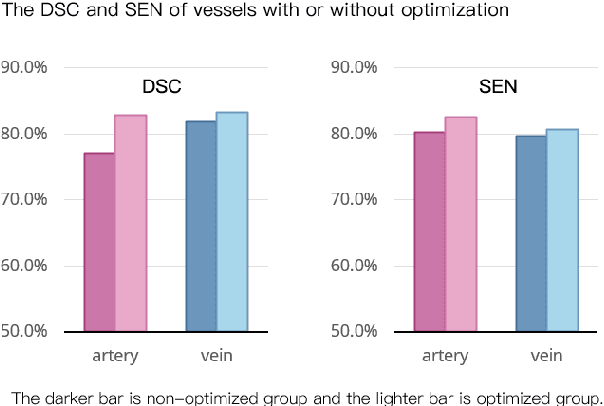
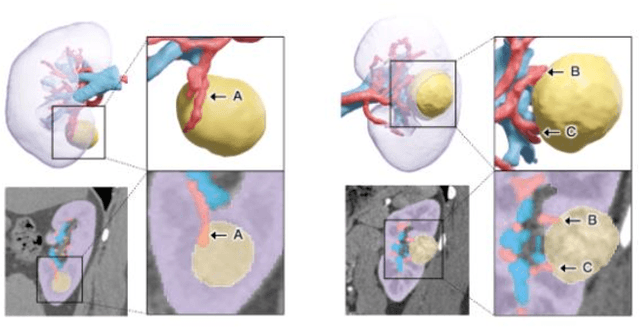
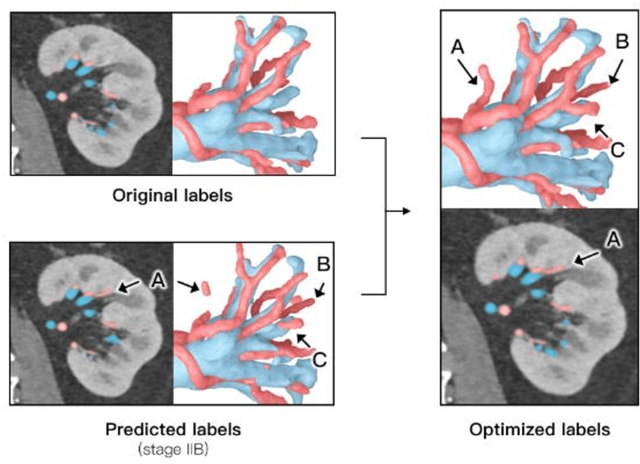
Abstract:Partial nephrectomy (PN) is common surgery in urology. Digitization of renal anatomies brings much help to many computer-aided diagnosis (CAD) techniques during PN. However, the manual delineation of kidney vascular system and tumor on each slice is time consuming, error-prone, and inconsistent. Therefore, we proposed an entire renal anatomies extraction method from Computed Tomographic Angiographic (CTA) images fully based on deep learning. We adopted a coarse-to-fine workflow to extract target tissues: first, we roughly located the kidney region, and then cropped the kidney region for more detail extraction. The network we used in our workflow is based on 3D U-Net. To dealing with the imbalance of class contributions to loss, we combined the dice loss with focal loss, and added an extra weight to prevent excessive attention. We also improved the manual annotations of vessels by merging semi-trained model's prediction and original annotations under supervision. We performed several experiments to find the best-fitting combination of variables for training. We trained and evaluated the models on our 60 cases dataset with 3 different sources. The average dice score coefficient (DSC) of kidney, tumor, cyst, artery, and vein, were 90.9%, 90.0%, 89.2%, 80.1% and 82.2% respectively. Our modulate weight and hybrid strategy of loss function increased the average DSC of all tissues about 8-20%. Our optimization of vessel annotation improved the average DSC about 1-5%. We proved the efficiency of our network on renal anatomies segmentation. The high accuracy and fully automation make it possible to quickly digitize the personal renal anatomies, which greatly increases the feasibility and practicability of CAD application on urology surgery.
Coexistence between Task- and Data-Oriented Communications: A Whittle's Index Guided Multi-Agent Reinforcement Learning Approach
May 19, 2022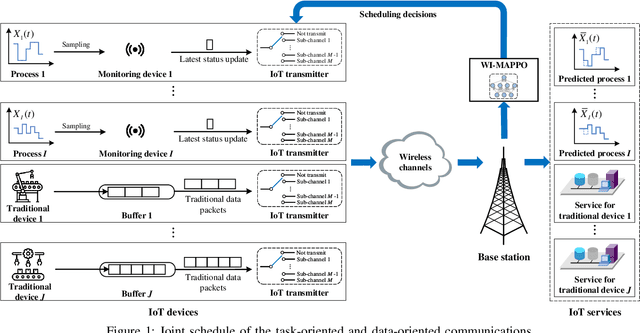
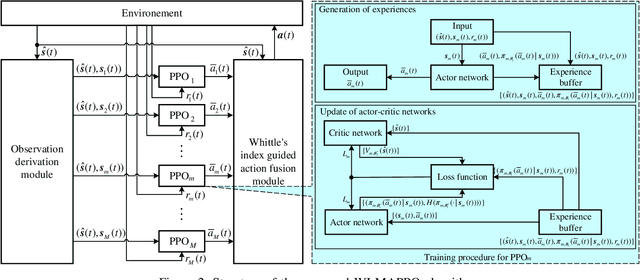
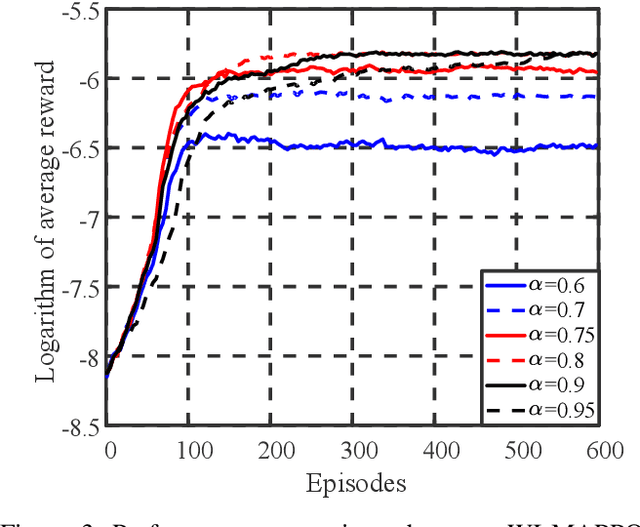
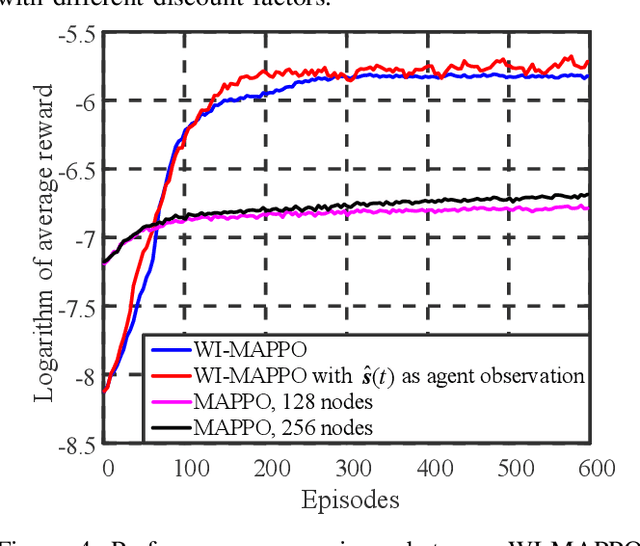
Abstract:We investigate the coexistence of task-oriented and data-oriented communications in a IoT system that shares a group of channels, and study the scheduling problem to jointly optimize the weighted age of incorrect information (AoII) and throughput, which are the performance metrics of the two types of communications, respectively. This problem is formulated as a Markov decision problem, which is difficult to solve due to the large discrete action space and the time-varying action constraints induced by the stochastic availability of channels. By exploiting the intrinsic properties of this problem and reformulating the reward function based on channel statistics, we first simplify the solution space, state space, and optimality criteria, and convert it to an equivalent Markov game, for which the large discrete action space issue is greatly relieved. Then, we propose a Whittle's index guided multi-agent proximal policy optimization (WI-MAPPO) algorithm to solve the considered game, where the embedded Whittle's index module further shrinks the action space, and the proposed offline training algorithm extends the training kernel of conventional MAPPO to address the issue of time-varying constraints. Finally, numerical results validate that the proposed algorithm significantly outperforms state-of-the-art age of information (AoI) based algorithms under scenarios with insufficient channel resources.
Weakly Supervised Learning Meets Ride-Sharing User Experience Enhancement
Jan 19, 2020



Abstract:Weakly supervised learning aims at coping with scarce labeled data. Previous weakly supervised studies typically assume that there is only one kind of weak supervision in data. In many applications, however, raw data usually contains more than one kind of weak supervision at the same time. For example, in user experience enhancement from Didi, one of the largest online ride-sharing platforms, the ride comment data contains severe label noise (due to the subjective factors of passengers) and severe label distribution bias (due to the sampling bias). We call such a problem as "compound weakly supervised learning". In this paper, we propose the CWSL method to address this problem based on Didi ride-sharing comment data. Specifically, an instance reweighting strategy is employed to cope with severe label noise in comment data, where the weights for harmful noisy instances are small. Robust criteria like AUC rather than accuracy and the validation performance are optimized for the correction of biased data label. Alternating optimization and stochastic gradient methods accelerate the optimization on large-scale data. Experiments on Didi ride-sharing comment data clearly validate the effectiveness. We hope this work may shed some light on applying weakly supervised learning to complex real situations.
 Add to Chrome
Add to Chrome Add to Firefox
Add to Firefox Add to Edge
Add to Edge